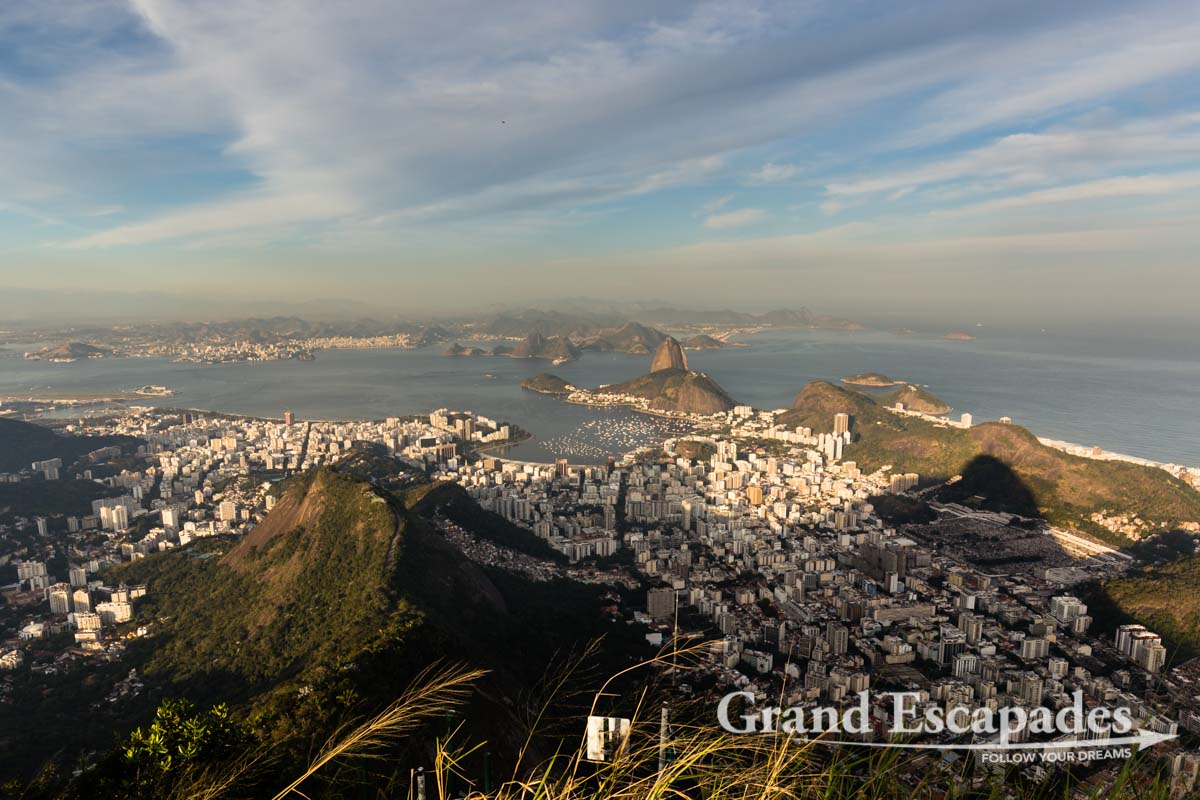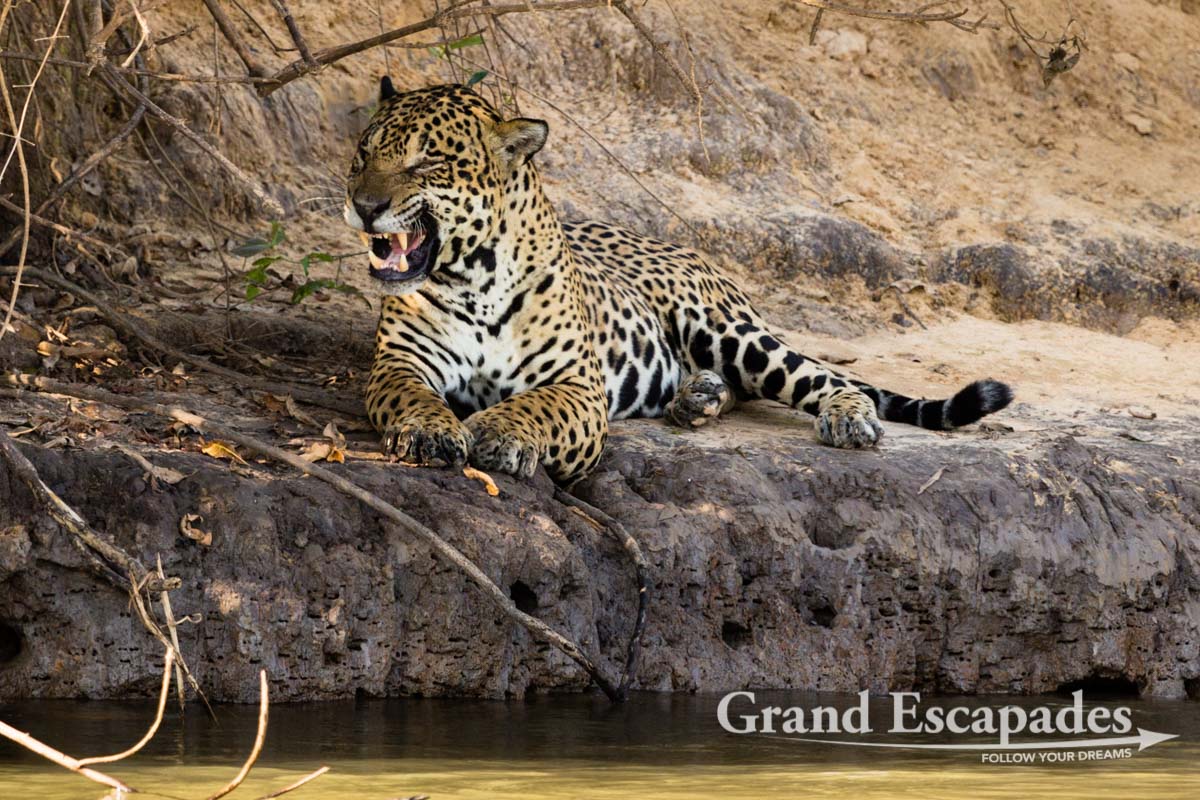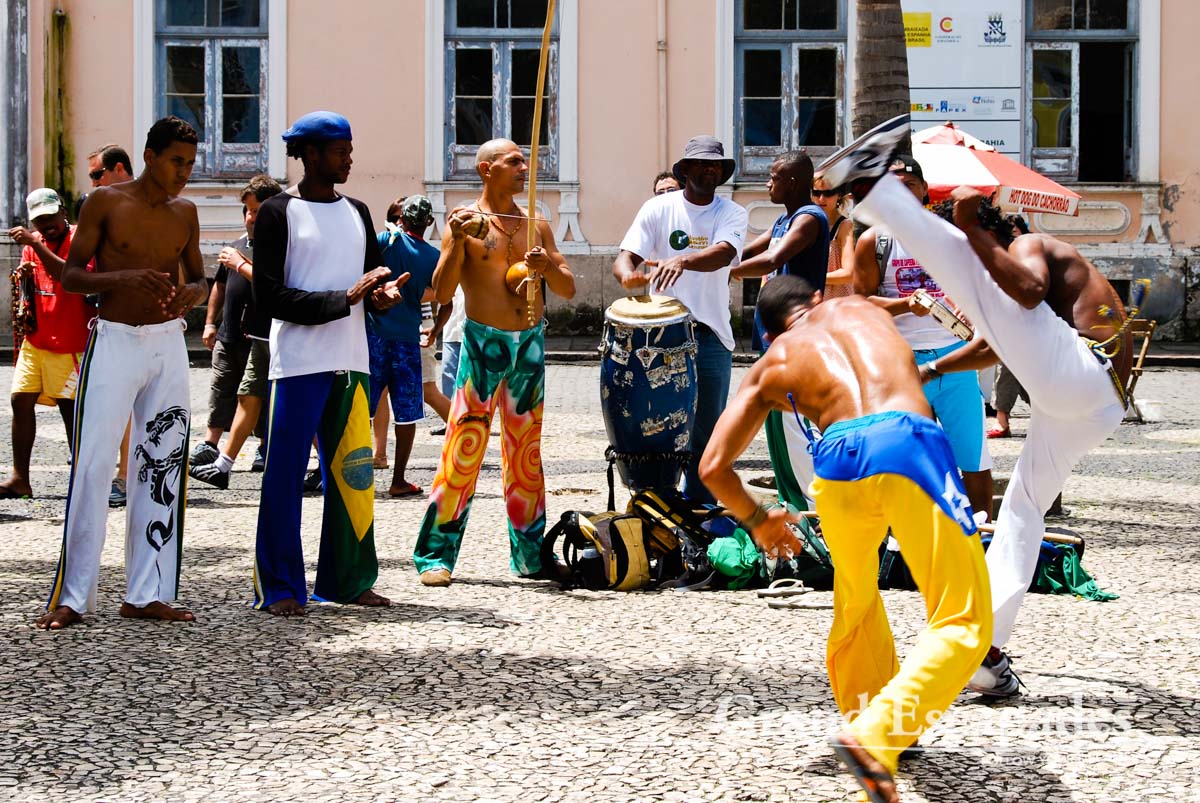Breathtaking Beaches, Splendid Colonial Cities, Unique Wildlife, Rio de Janeiro & … The Greatest Melting Pot!
Itinerary And Time Of The Visit
In 2007, I spent 4 weeks in Brazil and entered the country from Venezuela, discovering Manaus, Recife & Olinda, Fernando de Noronha, Salvador de Bahia & Morro de Sao Paulo, Rio de Janeiro & Sao Paulo. In 2015, I spent 6 weeks there and visited Salvador de Bahia & Morro de Sao Paulo, Minas Gerais (Belo Horizonte, Ouro Preto & Tiradentes), Rio de Janeiro & Ilha Grande, Iguazu (both Brazilian & Argentinian sides), Bonito, the Northern Pantanal (entering from Cuiaba and going to Porto Jofre), Brasilia & last but not least Sao Paulo.
Why Travel To Brazil?
Brazil has something for every taste, for every type of traveler and for most budgets (mostly the higher ones, though). The highlights of this country are so diverse that it is quite challenging to make such a list… You will find there:
- Some of the nicest and best preserved colonial cities (several a UNESCO World Heritage),
- Some of the most breathtaking natural sites (think of Iguazu Falls),
- Some of the richest wildlife watching opportunities,
- Some of the most breathtaking beaches in the world,
- Some of the best places to party you can imagine,
- Rio de Janeiro, in my opinion one of the most unique city in the world,
- And last but not least an immense diversity and a unique combination of people and cultures, as Brazil is probably the greatest Melting Pot one can find…
On top of that, the country is easy to travel and relatively safe if you exercise some basic precautions (see below: Is It Safe To Travel Brazil?). Nevertheless, the bad news is: it is not cheap! So plan your budget accordingly…
Challenges Organizing The Trip – What Would I Have Wished To Know?
Organizing a trip to Brazil is extremely easy: European citizens do not need a visa (North Americans are subject to “Reciprocity” and need one) and can stay up to 90 days. You can now book all air tickets online, which make things much easier (this wasn’t the case back in 2007). Cash is widely available at ATMs that you can find almost everywhere. Most hotels have very good websites in English (though staff may very well only speak Portuguese) and are easy to book.
The only restriction is that booking bus tickets is not possible online for non-residents (you need a so-called CPF-Number), but bus tickets are widely available even a few days before (maybe except during Carnival).
If you go for Carnival (which I haven’t done), consider booking months ahead, as everything will be sold out! And be ready for some extravagant prices on anything you can imagine…
Highlights Of The Trip
- Rio de Janeiro – Yes, there is something really special, almost mystical about this name: hardly any city stimulates as much the imagination. Deservedly!
- Iguazu Falls – No matter how many waterfalls you have seen in your life, these leave the most experienced travelers mumbling all kinds of words of excitement when you finally stand in front of the “Garganta del Diablo” or the “Salto San Martin”. In my opinion, these are the most spectacular waterfalls in the world, more impressive than Niagara Falls (USA), Victoria Falls (Zimbabwe) or Angel Falls (Venezuela).
- Some of the most superb Colonial Cities of the Americas
- Salvador de Bahia, a UNESCO World Heritage, the largest Colonial City of the Americas
- Ouro Preto, a UNESCO World Heritage Site, a superb Colonial City in a unique topography, Minas Gerais
- Tiradentes, a maze of cobblestone streets, Minas Gerais
- Mariana, the oldest city of Minas Gerais
- The Basilica of Congonhas, a UNESCO World Heritage Site, Minas Gerais
- Olinda Antigua, a UNESCO World Heritage
- The Pantanal – The largest tropical wetland area in the world is home to one of the greatest biodiversity on earth. Who doesn’t dream of spotting such an elusive “Big Cat” (the third biggest in the world, after Tigers & Lions) as the Jaguar?
- Brasilia – Only city built in the 20th Century listed as a UNESCO World Heritage, Brasilia is fascinating, disturbing and intimidating alike… There is much to do in Brasilia, and if you want to scratch bellow the surface, you will need several days to start grasping this futuristic yet anachronic city, in the heart of Brazil – An the best part of it: you will be the only non-Brazilian tourist!
- Breathtaking Beaches – No matter how long you spend in Brazil, you will never see all those long stretches of white sand lined with palm trees and turquoise waters… Both in Morro de Sao Paulo (especially Praia 4 and Praia 5) and on Ilha Grande (Praia Lopes Mendes), I found some of the most beautiful beaches I ever experienced, most of the time completely empty!
- Fernando de Noronha – Money doesn’t play a role for you? Then head for this National Park 350 kilometers off Recife, a small island offering some of the most breathtaking, deserted beaches, a unique wildlife for Snorkelers & Divers, and… Outrageous prices!
- Witnessing a true Melting-Pot – Brazil is the greatest (and actually only) true Melting Pot I have ever experienced, with people from all origins, all colors of skin, all physical types living together and mixing as if this was absolutely normal. True, some issues remain, and in the richest neighborhoods of Rio de Janeiro or Sao Paulo, this diversity is less obvious. But spend a few hours walking on La Copacabana, Ipanema or Leblon beaches, and you will witness a unique mix of people, something you had never observed before (and probably will probably never experience again).
How To Go Off The Beaten Track?
First, tourism focuses on a very limited number of landmarks, like Rio de Janeiro, Ouro Preto, Salvador de Bahia, Iguazu Falls, Ilha Grande… Many of the highlights of Brazil are actually completely Off The Beaten Track:
- Even in the highest “Jaguar Spotting Season”, there was a very limited number of visitors in the Northern Pantanal
- There were even less people in Bonito or in Tiradentes (Minas Gerais)
- And in Brasilia, I haven’t met a single foreigner in 4 days!
- I can imagine that northern Brazil is widely untouched, though I do not know this part of the country…
Besides, even in very popular places like Rio de Janeiro, Salvador de Bahia or Minas Gerais, you should take a few steps aside… Doing so, you will discover that you are the only tourist in many places you visit. If this is almost always true, this was even more noticeable in Brazil! So take the extra time and just wander away from the main drags and you will discover new aspects of the places or cities you visit, far away from the crowd that you find in some landmarks where large tour groups are the norm…
That said, you should always be alert when you go to more remote places in larger cities, and both lesson to your feelings and ask locals. It is better to just turn around than to create an accident…
What Will I Especially Remember?
- Brazil’s immense ethnic diversity: a Brazilian may look like somebody from Stockholm, from Spain, from Lagos, from Karachi, from Hanoi or from La Paz.
- The friendly and open-minded people of Brazil. The only downside I can find is that I missed being able to communicate with locals – with a few exceptions, it is Portuguese… or Portuguese!
- Thumbs up or two thumbs up – without this Brazilians could not communicate agreement.
- Some of the most incredible beaches I have ever experienced.
- People are fascinated by cheesy “Telenovellas” (TV-series). TVs can be found everywhere: in shops, in restaurants, in bus stations, at food stalls of street vendors, in doctor’s waiting rooms, at a car mechanics, etc …
- Being the only foreigners at many places, and hence being able to discover Brazil much more genuinely… Only at the REAL must see tourist haunts, like Sugar Loaf or Corcovado / Cristo Redendor in Rio de Janeiro did I see other non-Brazilian tourists (mainly large tour groups).
- The large beer bottles that come in a cooler and are always shared, and the very strong Caipirinhas
What Would I Do Differently?
- Go to Northern Brazil – This part of the country is obviously far less traveled.
- Focus on Snorkeling in Bonito – The other activities are extremely disappointing and overpriced.
- Avoid Fernando de Noronha – This is a beautiful island, but soooo overpriced!
- Spend more time in Rio – You need at least one week to really discover this unique city!
- Avoid the last row on a night bus – Always take seats towards the front, not in the back close to the toilets!
Is It Safe?
YES, Brazil is safe! There is stricktly no reason to be paranoid… I spent altogether 10 weeks in Brazil and neither did I encounter any problem myself, nor did I meet anyone who actually had problems (first hand). Of course you hear all those horrible stories, but if you stay alert and exercise some sound judgement, you should be absolutely fine!
Some of the basic rules are:
- Do not flash valuables except if you really feel it is safe
- Only carry with you what you need, your hotel room is much safer, especially in the evening, than some back streets. Especially: do not take your passport with you!
- Always have some cash with you that you can eventually hand to someone turning nasty. Not being able to give anything in case of an armed assault can be lethal!
- Carry two wallets, one with small change for everyday needs and one with credit cards and larger amounts of money if need be.
- Never leave your belongings unattended on the beach.
- And last but not least: always take cabs at nights in larger cities, and have those cabs called from a restaurant or a bar to be sure they are safe. This is all the more true if you have had a few Caipirinhas…
Best Time To Visit Brazil
Brazil has the size of a continent, therefore it is very difficult to clearly find a “best time” and a “worst time” to travel there…
- Peak Season is between Christmas and end of March, and if you plan to travel around Xmas / New Year, Carnival or Easter, book well ahead and be ready to pay accordingly. July and August are also busier months, due to European School Vacations. The lowest season is between April and June and September through November.
- The weather is cooler & dry during July & August, and can be very hot in the Brazilian summer (December through March). The wettest months are April to June.
- The best time for the Pantanal is August through mid October, when yours chances of spotting Jaguars are highest and the number of mosquitoes lowest.
Communication (Language Barrier?)
Communication in Brazil is indeed very challenging: except in some hotels, people speak… Portuguese! True, Spanish might help a little to be understood, but the answer in Portuguese won’t help a lot. Also museums are solely in Portuguese and can turn down right frustrating, as no other explanation can be found. No major worries though, communication always works out somehow!
Getting Around In Brazil
Brazil is HUGE! So traveling time & budget will be significant, even if you decide to focus on a part of the country.
- For long distances, always check the price of a flight instead of a bus: sometimes flying is actually cheaper than a very, very long bus drive.
- Bus ticket cannot be bought online for non-residents (you need a so-called CPF-Number), but bus tickets are widely available even a few days before (maybe except during Carnival). You will have to go to a travel agent or even to the Rodaviaria (Bus Station) to purchase your ticket.
- In Brasilia, renting a car is almost a must, and in Minas Gerais it significantly improves your flexibility. Driving in Brazil is quite easy.
| From | To | Type of Transport | Distance (Km) |
Travel Duration (Hours) |
Price (€) |
Price per 100 km (€) |
| Salvador de Bahia | Morro de Sao Paulo | Boat | 60 | 02:15 | € 33,81 | € 56,35 |
| Morro de Sao Paulo | Salvador de Bahia | Boat & Bus | 60 | 04:00 | € 33,81 | € 56,35 |
| Salvador de Bahia | Belo Horizonte | Plane | 960 | 01:23 | € 62,60 | € 6,52 |
| Belo Horizonte | Rio de Janeiro | Car Rental | 745 | € 186,39 | € 25,02 | |
| Rio de Janeiro | Ilha Grande | Boat & Bus | 106 | 05:00 | € 22,37 | € 21,10 |
| Ilha Grande | Rio de Janeiro | Boat & Bus | 106 | 03:30 | € 22,37 | € 21,10 |
| Rio de Janeiro | Foz do Iguacu | Plane | 1.183 | 02:12 | € 65,43 | € 5,53 |
| Foz do Iguazu | Puerto Iguazu | Taxi | 20 | 00:45 | € 4,21 | € 21,05 |
| Puerto Iguazu | Foz do Iguacu | Bus | 20 | 00:45 | € 2,11 | € 10,53 |
| Foz do Iguazu | Campo Grande | Bus | 705 | 13:30 | € 36,26 | € 5,14 |
| Campo Grande | Bonito | Bus | 260 | 04:00 | € 25,97 | € 9,99 |
| Bonito | Campo Grande | Bus | 260 | 05:00 | € 25,97 | € 9,99 |
| Campo Grande | Cuiaba | Bus | 708 | 15:40 | € 29,56 | € 4,18 |
| Cuiaba | Brasilia | Plane | 976 | 02:49 | € 106,23 | € 10,88 |
| Brasilia | Brasilia | Car Rental | 275 | € 162,46 | € 59,01 | |
| Brasilia | Sao Paulo | Plane | 1.175 | 01:28 | € 63,88 | € 5,44 |
| Total | 7.619 | 63:00 | € 883,43 | € 11,59 | ||
Red Tape
European citizens do not need a visa (North Americans are subject to “Reciprocity” and need one) and can stay up to 90 days.
Photography – Brazil: It Depends What Is Your Focus
- Colonial Architecture like in Minas Gerais
As always in Architecture Photography, the most important piece of equipment is a wide angle. I had just bought a new EF 16-35 L 4.0 and actually took 80% of the pictures with this lens. The lack of distance in those small cobblestone streets makes it extremely difficult to take pictures with a standard lens (like a EF 24-105 L 4.0). When using wide angel lenses a lot and post-processing your pictures, for instance in Lightroom, the new Upright – Automatic Perspective Correction is equally helpful. It corrects the tilted perspective by cropping the picture. Think about taking a wider frame of the subject, if possible! Moreover, many buildings are lit at night. Take your tripod, which will unable you to make some great pictures of the atmosphere of those colonial cities and of the main buildings (mostly churches) of the places you visit, especially in Ouro Preto. It is unfortunately forbidden to take pictures inside most churches. This is truly a shame, as those beautiful interiors would offer great photography opportunities.
- Beaches & People on the Beach
With some of the most beautiful beaches in the world, Brazil is the place to shoot some “Postcard-Like Pictures”. Especially at sunset (if the tide is right), you have some superb motives. Consider using a Polarization Filter to enhance contrast and to underexpose slightly.
Photographing people on the beach in Brazil is also good fun (especially the tiny Bikinis). There, you will need a strong tele-lens, as you might not want to play the paparazzi too obviously! A compact camera, for this, is a great help, also because you might not want to take an expensive DSLR with you if you plan to stay longer on the beach…
- Wild life like in the Pantanal
As a photographer, you will be confronted with numerous challenges in the Pantanal, so there are a few things to consider if you want to have the right equipment:
- A strong Tele-Lens
Yes, wildlife is mostly far away, and especially for birds, but also for Jaguars, you will need a strong tele-lens. I seldom reach the limits of my EF 100-400 f4.5-5.6, but in the Pantanal, especially with no crop-factor on my full-frame camera (Canon EOS 6D), I did! Take the strongest tele-lens you can find!
- Importance of the Speed of Focus
I use a Canon EOS 6D, and I truly appreciate this device for Travel Photography. The Full-Frame proved to be a real enhancement and opened new possibilities with difficult lights (higher ISO settings, under-exposures…). Also the integrated GPS is a great plus, even though it empties batteries within one day…
Nevertheless, for the first time I really reached the limits of my camera: the auto-focus is simply too slow for wildlife, which can be moving quite fast at times. I deeply regretted I hadn’t a Canon EOS 7D (Mark II) or of course a Canon EOS 5D Mark III with me…
- The lack of Light
Yes, we went wildlife watching during the day and I had troubles with not enough light, even under a scorching sun. How comes? Especially Jaguars tend to rest in the shade, as “Big Cats” do. So the lack of light will be a major challenge…
This is especially challenging with a tele-lens, as you need high shutter-speeds to avoid blurred images. Of course you can increase the ISO, but you have quickly a loss of quality. A full-frame camera will help partly, but only partly.
One trick is to move to “M” (“Manual”) and fix both Aperture (completely open as you want short depth of field range and as much light as possible) and shutter speed (at least 1 divided by your focal length, so in a case of a 400 mm lens at least 1 / 400 seconds). If you are strongly under exposed, then increase the exposure in the Post-Processing in Lightroom – Do not forget to shoot in RAW.
Best & Most Inspiring Travel Blogs For Brazil
Coming Soon…
Conclusion About Brazil…
After my first trip to Brazil in 2007, I wrote: “As a conclusion? Well, we will go back to Brazil, for sure…” The second trip didn’t disappoint me!
I found there an outstanding mix of people, culture, landscape, wildlife, beaches & party that each time made my trips diverse and rich. Depending on your priorities, you can travel there for one week or one month or several months, and each time have a genuine and intensive experience. Few countries offer such a possibility and such a mix!
Nevertheless, Brazil will challenge your budget! This is an expensive destination…






































